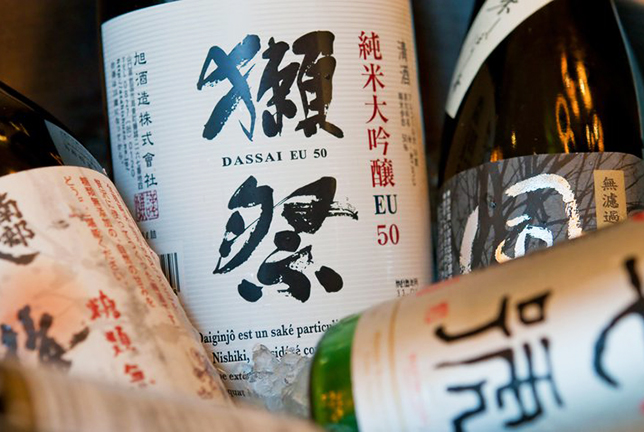
It was five decades ago in the trendy, high-end 5th arrondissement at 3 rue de la Valette, that Takumi Ashibe opened Takaraya, Paris’ very first Japanese restaurant. In the swinging ’60s, he moved the restaurant to Opéra and renamed it Takara; but it wasn’t until after he gave up the business that off-the-radar sake bars started opening, including the popular Sake Bar (found at Ashibe’s original rue de la Valette spot). The sake trend not having emerged on the mainstream Parisian culinary scene yet, bars remained underground and welcomed a largely Japanese business clientele. Fifty years later, every hotel worth its salt and every high-end Japanese restaurant now has a sake menu, sometimes elaborate enough to rival the wine list. As for Ashibe’s original restaurant, it was given a new lease of life — and a sake menu including some very eye-catching labels.
Three years ago, Takaraya’s complete transformation reached its final phase with a brand new style and name; the original Takaraya now goes under the name of Sola. Youlin Ly, the restaurant’s new owner, has gone right back to the source, and today Sola is one of those glittering places that is a must on any sushi and sake itinerary. However, the name on every self-respecting sake amateur’s lips is Toshiro Kuroda’s (the man behind sake institution Workshop Issé) more down-to-earth Izakaya Issé (izakaya denotes a casual bar where sake is usually served in Japan), which has more than 50 different sakes to try. And contrary to what below-average “fast food” sushi joints will have us believe, real sake can be paired with a meal, just like a good bottle of red wine. Sake novices beware: Grasping the ins and outs of sake (the word for all types of liquor in Japanese) is just as complex as understanding fine wines. If you want sake, you have to ask for it — or else you’ll be served rice wine, which is a simpler cruder version of sake.
Today, the aim for sake magnates that brew popular premium sake such as Kakunko and Dassai, already fairly well known in the United States, is to get the precious national Japanese beverage onto restaurant wine lists. For a 720mL bottle, prices range from $15 to $200, and prices are bumped up in restaurants and bars.
The Parisian sake revolution also manifests itself in the shape of its very own fair: Sake Tasting. The first edition took place last summer, and more than 85 brands and 100 sakes were showcased. Organized by Ly and “sake samurai” Sylvain Huet (founder of the Sake Academy and the Sake Club), “the fair was first and foremost created to fight against the misguidance in sake tasting, and aims to provide a guide to better understanding this age-old Japanese tradition,” Huet says.
The exact origins of sake are unknown but the earliest reference to the beverage date back to at least the Kojiki (Japan’s first written history) in 712 AD and it has remained a firm part of Japanese tradition both at home and at restaurants and bars ever since.
Between 14 and 19 percent in alcohol content, the delicate and slightly bitter rice wine, where the rice undergoes a fermenting process similar to that used for beer, can be infused with fruit, spices or flowers, giving it a subtle flavor — and it’s stirring up great intrigue among Parisians.
Rice in sake is the equivalent of grapes in wine. And just like grapes, there are dozens of types of rice used to obtain a specific flavor. The flavor also depends on the extent to which the grains have been polished; the higher the polish, the better the quality of the sake. Dassai sake for example, is 77 percent polished — the equivalent of 144 hours of polishing.
Although not actual sake bars, you can also sample sake “grands crus” at some of the city’s high-end hotels including Le Royal Monceau Raffles Paris, Shangri-La Hotel Paris and Mandarin Oriental, Paris. La Grande Epicerie (Le Bon Marché) stocks top sake brands to take home, the BHV (Bazar de l’Hôtel de Ville) recently opened a sake bar on its fifth floor and bars Silencio and Prescription Cocktail Club whisk up unusual sake-based cocktails worth stopping by for a sakeology lesson with a twist.
Photo Courtesy of WorkshopIsse

